

The main advantages of the guided surgery system are the reduction of surgical time and a minimal invasion, which means a better postoperative period
Introduction
When we talk of digital dentistry or of dentistry 4.0, it is sometimes necessary to give real examples to illustrate in the clearest possible manner the full extent of this change.
The sector is evolving at a rapid pace and one of the consequences of this is that surgical operations like the one we present below are becoming increasingly routine.
An extensive range of technologies and products are involved in the processes and methods used in this surgical operation, making it an excellent example of the way modern dentistry is impacting on everyday clinical practice.
This case demonstrates the importance of good scanning using 3Shape TRIOS intraoral scanners, as well as the competitive advantage provided by planning software such as Implant Studio for planning and designing surgical guides. A good guided surgery system is essential for performing this treatment successfully. Similarly necessary is the ability to 3D-print surgical guides using biocompatible materials that can also be sterilized, such as polyamide.
AVINENT aims to support clinicians and facilitate their leap to a completely digital workflow, which will enable them to carry out treatments like the one performed by Dr. Jesús López Vilagran and Dr. Martí Pagès. In this instance, Dr. López Vilagran describes the details of the case and shows how good use of the new digital tools, combined with extensive experience in surgical protocols, can lead to outstanding results. This case is an example of speed, efficiency, and success in a minimally invasive surgical operation intended to continue to improve the patient’s experience.

Case history
Edentulous patient aged 66 with no relevant illnesses (he smokes five cigarettes a day) who had full upper and lower prostheses. He visited the clinic due to a desire to improve his masticatory function.
Procedure
Following upper and lower cone-beam computed tomography to analyze the remaining bone in both maxillae, it was determined that there was sufficient bone to place eight AVINENT Ocean implants in the upper arch and six in the lower arch for implant-supported upper and lower fixed prostheses, to be made subsequently.
Having analyzed during the clinical exploration that the patient had sufficient keratinized tissue in both arches, the decision was made to plan the guided surgery with a view to placing the implants with the least invasion and the best postoperative period possible, as the implant placement would be transmucosal.
The implant planning was based on an esthetic and functional trial in Implant Studio (3Shape). Using the patient’s full prostheses, which we scanned using the TRIOS (3Shape) intraoral scanner, we made radiographic guides that would serve to guide our implants.
Following the guided planning in Implant Studio, surgical guides were designed and printed in polyamide.
These guides were mucosa-supported and each one was stabilized using three anchor pins. These anchor pins facilitate precise surgery in accordance with the treatment plan: they hold the surgical template in place during surgery and during the making of the master model. The guides have two parts that can be dismantled and which enable them at the start to be fixed in the correct position using the anchor pins. Subsequently this second part is dismantled in order to begin the guided surgery in accordance with the protocol for AVINENT OCEAN IC implants.
Conclusions
Thanks to the various benefits of this technique, we considerably reduce the number of visits the patient needs to make to the clinic, thereby improving their ultimate satisfaction with more convenient and quicker treatment.
In addition, guided surgery means minimally invasive surgery, given that it was conceived to reduce to the minimum any bone graft interventions. Another of its main benefits is the reduced time taken to perform surgery, which is much shorter.
To sum up, as remarked earlier, the main advantages of the guided surgery system are: